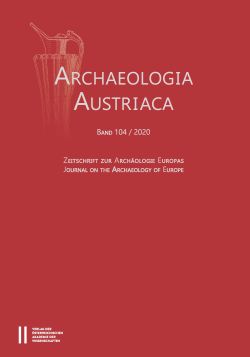|
 |
Sophie Zimmermann, Barbara Horejs
Editorial
Artikel / Articles
Doris Pany-Kucera, Michaela Spannagl-Steiner, Lukas
Waltenberger, Walther Parson, Christina Strobl, Barbara
Rendl, Lukas Janker, Fabian Kanz, Katharina Rebay-
Salisbury
Social Relations, Deprivation and Violence at Schleinbach,
Lower Austria. Insights from an Interdisciplinary Analysis of
the Early Bronze Age Human Remains
Appendix 1. Catalogue of Human Remains from Schleinbach –
ONLINE, doi: 10.1553/archaeologia104s13-A
Anika Retzmann, Anna-Maria Kriechbaum, Monika Griebl,
Karin Wiltschke-Schrotta, Maria Teschler-Nicola, Johanna
Irrgeher, Thomas Prohaska
Sr Isotope Analysis of Human Remains from Settlement Pits
at Stillfried/March. Reappraising Diagenetic Changes
Ernst Pernicka, Jörg Adam, Gregor Borg, Gerhard
Brügmann, Jan-Heinrich Bunnefeld, Wolfgang Kainz,
Mechthild Klamm, Thomas Koiki, Harald Meller, Ralf
Schwarz, Thomas Stöllner, Christian-Heinrich Wunderlich,
Alfred Reichenberger
Why the Nebra Sky Disc Dates to the Early Bronze Age. An
Overview of the Interdisciplinary Results
Leandra Reitmaier-Naef, Peter Thomas, Julia Bucher,
Monika Oberhänsli, Caroline O. Grutsch, Klaus-Peter
Martinek, Mathias Seifert, Philippe Rentzel, Rouven Turck,
Thomas Reitmaier, Philippe Della Casa
Mining at the Fringes. High-Altitude Prehistoric Copper
Mining in the Oberhalbstein Valley (Grisons, Switzerland)
Appendix 1. Supplementary Data – ONLINE,
doi: 10.1553/archaeologia104s123-A
Anja Hellmuth Kramberger
„Sonnenbarken“ und „Mondscheiben“ im bronzezeitlichen
Istrien? Zu zwei besonderen Schalen mit verziertem Boden
aus der Gradina von Monkodonja nahe Rovinj, Kroatien
Annalisa Rumolo
Treazzano di Monsampolo, a Recent Bronze Age Settlement
in the Middle Adriatic Area
Laetitia Phialon
Thoughts on the Capacities of Goblets and Consumption
Practices in Middle Helladic and Early Mycenaean Settlements
Appendix 1. Supplementary Data: Capacities of Drinking Vessels
and Tableware – ONLINE, doi: 10.1553/archaeologia104s195-A
Paul Gleirscher
Keltischer oder etruskischer Einfluss? Ein späthallstattzeitlicher
Armreif mit gegenständiger Kopfzier aus Möllbrücke
(Kärnten)
Nives Doneus, Igor Miholjek, Kristina Džin, Michael
Doneus, Pavle Dugonjić, Hannes Schiel
Archaeological Prospection of Coastal and Submerged
Settlement Sites. Re-Evaluation of the Roman Site Complex
of Vižula, Croatia
Mária Műllerová
New Synthesis of Early Medieval Iron Hoards from Slovakia
Martin Neumann
Standortwahl des Kalvarienberges im Vorfeld der Burg
Červený Kameň (SW-Slowakei)
Rezensionen / Reviews
Eva Lenneis
Joanna Pyzel (Hrsg.), Ludwinowo, stanowisko 7: Osada
neolityczna na Kujawach / Ludwinowo, Site 7: Neolithic
Settlement in Kuyavia. Ocalone dziedzictwo archeologiczne
8 / Saved Archaeological Heritage 8 (Profil-Archeo
Publishing House and Archaeological Studio, University of
Gdańsk Publishing House, Pękowice – Gdańsk 2019)
Jörg Weilhartner
Louis Godart, Anna Sacconi, Les archives du roi Nestor:
Corpus des inscriptions en linéaire B de Pylos. Vol. 1: séries
Aa–Fr, Vol. 2: séries Gn–Xn. Pasiphae 13–14 (Fabrizio Serra
Editore, Pisa – Rom 2019–2020)
und / and
Jean-Pierre Olivier, Maurizio Del Freo, The Pylos Tablets Transcribed:
Deuxième Édition (Libreriauniversitaria.it edizioni,
Padua 2020)
Felix Höflmayer
Birgit Schiller, Handel in Krisenzeiten: Ägyptisch-mykenische
Handelsbeziehungen in der Ramessidenzeit (Archaeopress,
Oxford 2018)
Ernst Czerny
Florian Ebeling, Christian E. Loeben (Hrsg.), O Isis und
Osiris – Ägyptens Mysterien und die Freimaurerei. Museum
Kestnerianum
21 (Verlag Marie Leidorf, Rahden/Westfalen
2018)
Karl Krierer
Stephan G. Schmid, Sophie G. Horacek (Hrsg.), “I don’t
know what am I myself, it is so very difficult to explain.”
Max Ohnefalsch-Richter (1850–1917) und die Archäologie
Zyperns. Studia Cyprologica Berolinensia 1 (Logos Verlag,
Berlin 2018)
|




